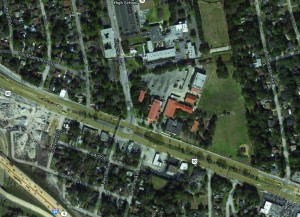Sentimentalism not enough to stop progress Live Oaks bite the dust for Overland Bridge project
Posted on December 31, 2014 By Editor Articles, Neighborhood News, Top Stories
When progress hits sentimental history head on, even though there may be a strong and vocal group of advocates for preserving that history, progress seems to win nearly every time.
This too is the case with an aspect of the Overland Bridge Project.
About 25 years ago, residents of the South Shores neighborhood and of St. Nicholas got together for a beautification project in the Atlantic Boulevard median that stretches from Old Hickory Road to Holmesdale Road, in front of Bishop Kenny High School and Assumption Catholic Church and School.

A stretch of Atlantic Boulevard included a tree-lined median separating the east and westbound lanes.
Partially funded through a matching grant from Greenscape, the neighbors raised the money needed to purchase a number of mature live oaks, holly trees and crape myrtles to help deaden noise of traffic along the boulevard and to improve the appearance of the area.
George Kruer, a South Shores resident, recalls that a year or two after planting the trees, a drought hit the area and he would stretch garden hoses across two lanes of highway from Van’s Automotive, where he tapped into a water spigot. “I felt pretty vested in the trees,” he said.
Then four years ago, when the Florida Department of Transportation (FDOT) held a series of public meetings, residents questioned the survival of the trees.
The concerned homeowners who attended the original charrettes – controlled brainstorm design meetings – with the FDOT had thought that those trees were slated to survive the project.
“We were consistently mindful to do everything we could to keep the trees and upgrade the look of the ramp area from the ‘urban blight’ look it displayed during the ‘Doll House days,’” said a resident who wished to remain anonymous. “By having lovely landscaping at the entrance to our neighborhood this would make worthwhile all the noise and vibration we have been enduring as the construction got more intense.”
That was the game plan until a couple of months ago.
While the FDOT initially said that they would lose some of the trees, Kruer said “We were shocked to see the clear cut.”
Most of the trees adjoining the neighborhood were cut down early in the project. Then a couple of months ago Kruer noticed that construction workers were parking vehicles and heavy equipment under the remaining trees – on top of the roots. “My concern was for the remaining trees,” Kruer stated. “We quickly requested protective orange netting around the root zone of the remaining trees.”
According to Kruer, there is ample places for the construction workers’ vehicles to be parked elsewhere. “I walk approximately two blocks from my parking spot each day so I don’t think this would be a huge inconvenience to protect a 25+ year old tree.”
In late October the FDOT was contacted by South Shores Neighborhood Association asking to have the remaining trees spared from removal. Ron Tittle, public information officer for FDOT, responded by email indicating that “the engineer inspection team is working with the contractor to determine which trees are scheduled to be removed. The surveyors are being asked to tie a ribbon around the trees scheduled to remain.”
The plan was to install drainage pipes down the length of the median and the residents hoped there would be a work-around to retain the trees. Unfortunately, one month later, just one live oak remained standing. Tittle indicated that the engineer and construction teams attempted to develop alternatives but no plan was feasible.
“Every large project such as the Overland Bridge Project takes protective measures for tree root zones,” Kruer stated. “Out of all the beautiful live oaks the South Shores Association paid to plant, there is only one large live oak standing, but it is also probably destined for the chainsaw.”
It does not appear that any trees will be left in the median. A thorough review of traffic control plans along Atlantic Boulevard between Old Hickory and Kingman Avenue was conducted, according to Tittle. “It is not possible to save the trees in this area,” he explained. “The median is required in order to shift traffic and allow for construction of the new Atlantic Boulevard on-ramp.”
FDOT’s landscape engineer was asked about the possibility of a future landscape project, but Tittle noted that the engineer is concerned about available areas to plant landscaping. The possibility of a landscape project could be evaluated at a future date once the Overland Bridge project is finished.
By Kate A. Hallock
Resident Community News




 (No Ratings Yet)
(No Ratings Yet)




